Endergonic Study guides, Class notes & Summaries
Looking for the best study guides, study notes and summaries about Endergonic? On this page you'll find 745 study documents about Endergonic.
Page 4 out of 745 results
Sort by
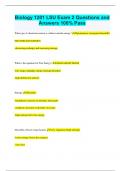
-
Biology 1201 LSU Exam 2 Questions and Answers 100% Pass
- Exam (elaborations) • 14 pages • 2024
- Available in package deal
-
- $9.99
- + learn more
Biology 1201 LSU Exam 2 Questions and Answers 100% Pass What type of chemical reaction is without outside energy? Spontaneous (exergonic/downhill) NOT INSTANTANEOUS -decreasing enthalpy and increasing entropy What is the equation for Free Energy? deltaG=deltaH-TdeltaS -free enrgy=enthalpy-(temp.)(entropy;disorder) -high deltaS=low delta G Entropy Disorder: -breakdown: increase in disorder, more parts -synthesis: decrease in disorder, less parts -high entropy=low free energy ...
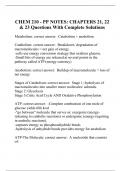
-
CHEM 210 - PP NOTES: CHAPTERS 21, 22 & 23 Questions With Complete Solutions
- Exam (elaborations) • 20 pages • 2023
-
Available in package deal
-
- $12.99
- + learn more
Metabolism: correct answer: Catabolism + anabolism Catabolism: correct answer: Breakdown/ degradation of macromolecules = net gain of energy. -cells use energy conversion strategy that oxidizes glucose. -Small bits of energy are released at several points in the pathway called ATP (energy currency) Anabolism: correct answer: Buildup of macromolecule = loss of net energy Stages of Catabolism: correct answer: Stage 1: hydrolysis of macromolecules into smaller micro molecules/ subuni...
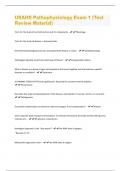
-
USAHS Pathophysiology Exam 1 (Test Review Material) 240 Questions and Answers(A+ Solution guide)
- Exam (elaborations) • 40 pages • 2023
- Available in package deal
-
- $15.99
- + learn more
Term for the study of normal function and it's components - Physiology Term for the study of disease, a diseased state. Disordered physiological processes associated with disease or injury. - pathophysiology Pathologies typically result from what type of failure? - Compensation failure What is known as a group of signs and symptoms that occur together and characterize a specific disorder or condition? - Syndrome A DYNAMIC STEADY STATE (not equilibrium). Required for constant internal stab...
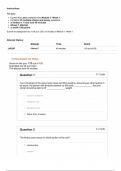
-
EXSC 505 Quiz Body Systems, Biomechanics, and Bioenergetics (Liberty university)
- Other • 13 pages • 2024
-
- $23.49
- + learn more
Two individuals of the same body mass are lifting weights. Assuming all other factors to be equal, the person with tendons inserted on the bone the joint center should be able to lift weight. closer to; a heavier medial to; less laterally to; less farther from; a heavier Question 2 3/3 pts The Krebs cycle occurs in which portion of the cell? mitochondria nucleus membrane cytoplasm Question 3 3/3 pts An athlete produced 840 watts of power in 0.6 seconds. How much work ...
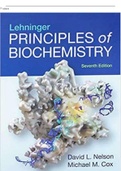
-
Test Bank: Lehninger Principles of Biochemistry, 7th Edition, David L. Nelson (Complete Download) . All Chapters 1-28
- Exam (elaborations) • 648 pages • 2022
-
- $15.59
- 1x sold
- + learn more
1. In a bacterial cell, the DNA is in the: A) cell envelope. B) cell membrane. C) nucleoid. D) nucleus. E) ribosomes. 2. A major change occurring in the evolution of eukaryotes from prokaryotes was the development of: A) DNA. B) photosynthetic capability. C) plasma membranes. D) ribosomes. E) the nucleus. 3. In eukaryotes, the nucleus is enclosed by a double membrane called the: A) cell membrane. B) nuclear envelope. C) nucleolus. D) nucleoplasm. E) nucleosome. 4. T...
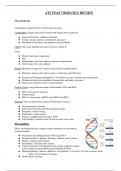
-
ATI TEAS 7 BIOLOGY REVIEW
- Exam (elaborations) • 55 pages • 2023
-
Available in package deal
-
- $15.00
- + learn more
Macromolecules: Carbohydrate, Lipid, Nucleic Acid, Protein, Enzyme Carbohydrate: Sugars and starches which body breaks down to glucose ● Structural function: cellulose and chitin ● Energy storage: amylose, amylopectin, glycogen ● Recognition molecules: glycoproteins and glycolipids Lipids: Fatty acids and their derivatives that are soluble in water ● H and C and main components ● Fats ● Hydrophobic- thus help separate aqueous compartments ● Store energy (fats, oils, adip...
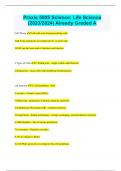
-
Praxis 5005 Science: Life Science (2023/2024) Already Graded A
- Exam (elaborations) • 21 pages • 2023
- Available in package deal
-
- $9.99
- + learn more
Praxis 5005 Science: Life Science (2023/2024) Already Graded A Cell Theory 1)all cells arise from preexisting cells 2)all living organisms are composed of 1 or more cells 3)Cells are the basic unit of structure and function 2 Types of Cells 1) Prokaryotes - single-celled called bacteria 2) Eukaryotes - many cells with membrane-bound nucleus cell anatomy 1) cell membrane - door 2) nucleus - Control center (DNA) 3) Ribosome - production of protein; made by nucleolus 4) Endoplasmic Reticulum (ER)...
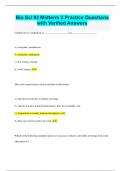
-
Bio Sci 93 Midterm 2 Practice Questions with Verified Answers
- Exam (elaborations) • 14 pages • 2024
- Available in package deal
-
- $9.99
- + learn more
Bio Sci 93 Midterm 2 Practice Questions with Verified Answers Catabolism is to anabolism as ___________________ is to ___________________. a.) exergonic; spontaneous b.) exergonic; endergonic c.) free energy; entropy d.) work; energy b Most cells cannot harness heat to perform work because a.) heat does not involve a transfer of energy. b.) cells do not have much thermal energy; they are eventually cool. c.) temperature is usually uniform throughout a cell. d.) heat can neve...
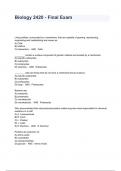
-
Biology 2420 - Final Exam Questions And Answers
- Exam (elaborations) • 31 pages • 2023
- Available in package deal
-
- $12.99
- + learn more
Biology 2420 - Final Exam Questions And Answers Living entities, surrounded by a membrane, that are capable of growing, reproducing, responding and metabolizing are known as: A) Cells B) biofilms C) bioreactors - ANS Cells ________ contain a nucleus composed of genetic material surrounded by a membrane: A) pseudo eukaryotes B) eukaryotes C) prokaryotes D) enzymes - ANS Eukaryotes ________ cells are those that do not have a membrane-bound nucleus: A) pseudo eukaryotes B)...
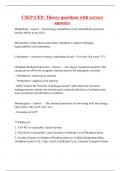
-
CSEP-CEP: Theory questions with correct answers
- Exam (elaborations) • 106 pages • 2023
- Available in package deal
-
- $13.99
- + learn more
Metabolism - Answer Total energy expenditure of all cata/anabolic processes (bodies ability to use fuel) Measured by either direct (calorimetry chamber) or indirect (Douglas bag/metabolic cart) calorimetry Calorimetry = measure of energy expenditure (kcals = E to heat 1kg water 1°C) Oxidation-Reduction Reaction - Answer - Are always *coupled reactions* (the energy given off by the exergonic reaction powers the endergonic reaction) - *Oxidation*: removing an electron - *Reduction*...

Study stress? For sellers on Stuvia, these are actually golden times. KA-CHING! Earn from your study resources too and start uploading now. Discover all about earning on Stuvia


